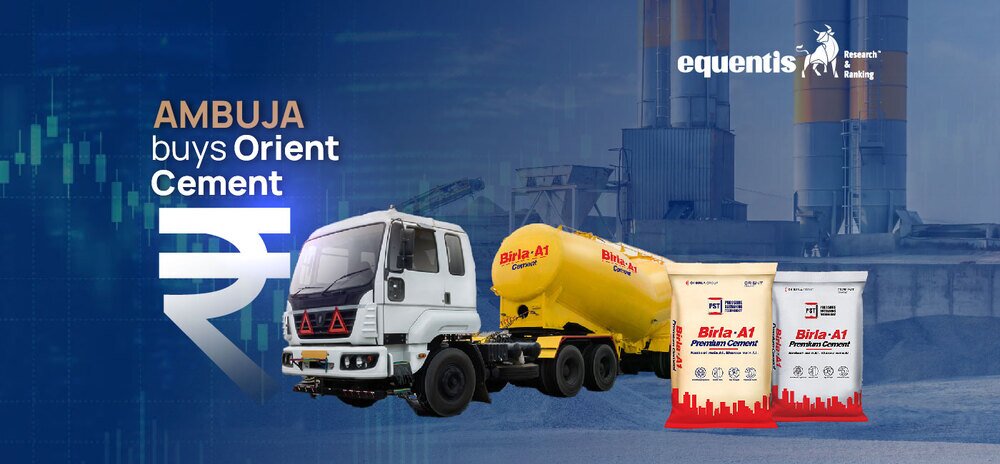How does a ₹8,100 crore deal impact the Indian cement industry? How does it position Ambuja Cements, an Adani Group company, in its race to reach 100 million tonnes per annum (MTPA) cement capacity by 2025? These are the key questions that the latest acquisition by Ambuja Cements raises as the company continues its aggressive expansion strategy under the leadership of Adani Group.
On Tuesday, Ambuja Cements announced it will acquire a 46.8% stake in Orient Cement Ltd (OCL) for an equity value of ₹8,100 crore. This deal aims to bring Ambuja Cements closer to its target of achieving 100 MTPA capacity by the 2025 financial year and increasing its market share across India by approximately 2%.
Key Details of the Acquisition
The acquisition will take place in two stages. First, Ambuja Cements will acquire 37.9% of Orient Cement’s shares from the company’s promoters and 8.9% from select public shareholders. Following this, Ambuja plans to launch an open offer to acquire an additional 26% stake in OCL’s expanded share capital.
The open offer will be priced at ₹395.40 per share, in line with the Substantial Acquisition of Shares and Takeovers (SAST) regulations. This open offer is expected to be completed within 3-4 months. Source: MoneyControl
This is Ambuja Cements’ fifth major acquisition since Adani Group took control of the company in September 2022. Prior to this, Ambuja made headlines with its June acquisition of Hyderabad-based Penna Cement, signaling its intention to consolidate its presence in South India. This latest move adds to Ambuja’s production capacity, boosting it by 8.5 million tonnes and bringing its total cement capacity to 97 MTPA. The company has set an ambitious goal of reaching 140 MTPA by 2028.
Strategic Significance of the Deal
Orient Cement’s plants in Telangana, Karnataka, and Maharashtra are crucial to Ambuja’s strategy to expand its footprint in South India.
The South Indian market is seen as a hotspot for infrastructure-driven demand, with major projects like the development of Andhra Pradesh’s new capital, Amravati, set to drive cement consumption. The Union Budget 2024 allocated ₹15,000 crore for Amravati’s development, which is expected further to spur demand for construction materials, including cement.
The acquisition also provides Ambuja access to Orient’s high-quality limestone reserves, an essential raw material in cement production. With existing statutory approvals in place, there is potential to increase Orient’s cement capacity from its current 8.5 MTPA to 16.6 MTPA in the near future. Source: Livemint
Competitive Landscape: Ambuja vs. UltraTech
Ambuja’s aggressive expansion in South India puts it head-to-head with UltraTech Cement, India’s largest cement producer, currently holding over 180 MTPA capacity. UltraTech, a key competitor, aims to reach 200 MTPA by 2027 and has also been expanding its presence in the South with its acquisition of Penna Cement.
The southern region is becoming a key battleground for cement companies due to the expected rise in infrastructure demand. Cement firms are scrambling to secure production capacity to meet the upcoming demand boom, and Ambuja’s acquisition of Orient Cement is a significant step in this direction.
Stock Market Reaction
The news of the acquisition immediately impacted the stock prices of both Ambuja Cements and Orient Cement. Ambuja’s shares rose modestly, trading up 1.49% at ₹580 on the announcement day, while Orient Cement’s shares increased by 1.65%, trading at ₹358.25. However, despite this initial positivity, both companies’ stocks experienced a decline amid broader market corrections. Ambuja’s stock closed 2.4% lower at ₹558, while Orient Cement fell 2.5% to ₹343.4.
Despite this short-term dip, Ambuja’s stock performance over the past year has been strong. Its share price has risen by 35%, significantly outpacing the 24% gain in the benchmark Sensex.
Adani’s Cement Strategy
Adani Group entered the cement sector by acquiring Ambuja Cements and ACC Limited in September 2022 for $10.5 billion, a strategic move to fill a key gap in its infrastructure portfolio. With its substantial interests in coal, power, logistics, and real estate, Adani saw significant synergies in integrating cement production into its ecosystem.
These synergies offer Ambuja the potential for cost reductions in cement production, as Adani’s coal and power businesses provide essential inputs for the energy-intensive cement manufacturing process. This vertical integration is expected to give Ambuja a competitive edge in cost and efficiency.
In addition to the Orient Cement acquisition, Ambuja also acquired Sanghi Industries in Gujarat in August for an enterprise value of ₹5,000 crore. Sanghi Industries’ 6.1 MTPA production capacity further strengthens Ambuja’s market position, particularly in Western India.
Source: Economic Times
Conclusion
With the acquisition of Orient Cement, Ambuja Cements is solidifying its position as one of the dominant players in the Indian cement industry. The deal brings the company closer to its 100 MTPA capacity goal and enhances its presence in the crucial South Indian market. While Ambuja still faces stiff competition from industry leader UltraTech, its strategic acquisitions and synergies within the Adani Group position it well for the future.
*Disclaimer Note: The securities quoted, if any, are for illustration only and are not recommendatory. This article is for education purposes only and shall not be considered as recommendation or investment advice by Research & Ranking. We will not be liable for any losses that may occur. Investment in securities market are subject to market risks. Read all the related documents carefully before investing. Registration granted by SEBI, membership of BASL, and certification from NISM in no way guarantee the performance of the intermediary or provide any assurance of returns to investors.
How useful was this post?
Click on a star to rate it!
Average rating 5 / 5. Vote count: 1
No votes so far! Be the first to rate this post.
I’m Archana R. Chettiar, an experienced content creator with
an affinity for writing on personal finance and other financial content. I
love to write on equity investing, retirement, managing money, and more.
























